Al fin he recibido los comentarios de Dr. B. a la tesis. Tengo gran admiración por Dr. B., así que me interesaba especialmente lo que me fuera a decir. Lo suyo es Aristóteles, pero es un platónico-aristotélico, gran conocedor de la República y del Fedón. Su clase “Aristotle: Intellect and Intellectual Virtue” fue una de mis favoritas del doctorado. Da un curso chulísimo en el pregrado sobre la República en la que pide a sus estudiantes que lean durante el verano la Ilíada, la Odisea, la Teogonía de Hesiodo, Ifigenia en Áulide de Eurípides, el Tiestes y el Agamenón de Séneca, Las Nubes de Aristófanes. Y luego, durante el curso, leen la República y la Orestíada de Esquilo. Así explica en el syllabus esta unión de épica, tragedia y filosofía:
My motivating pedagogical principle in designing this course is both Aristotelian and Thomistic— what the tradition calls conversio ad phantasmata—namely that philosophy can neither be pursued nor practiced without concrete images. According to this tradition, images and appearances are not only necessary for acquiring theoretical knowledge as its origin and prerequisite, but they remain necessary also for exercising knowledge already achieved. Appearances and real objects remain (as Newman has it) “the scope and end and the test” of abstract notions and theoretical reflection. “For,” as Aristotle has it, “the end of productive knowledge is the work produced, while the end of scientific knowledge is always what appears authoritatively according to perception.”
It’s common for philosophers to treat literary and historical phenomena as the messy or even dangerous stuff from which philosophical reflection can begin, but which can and must be set aside as soon as we achieve abstract precision and universal necessity about these matters. Indeed, this even fits with a certain interpretation of Plato’s Republic. My approach, by contrast, treats literary images and historical examples not only as the matter from which philosophical reflection comes to be, but also as the matter in which it lives and breathes. Just as in the Republic itself, in the end, we must return to myth, reentering the cave. Unlike rival approaches, then, in this course we shall be attentive to what Plato’s Socrates does with images, poetry, and myth, not only to what he says.
Besides other excerpts from Greek history and literature, we shall read Aeschylus’ Oresteia, the only surviving tragic trilogy from this period. The Oresteia explores the very same themes of justice, upbringing, and leadership as the Republic. We therefore study two of the most important texts from Ancient Greece, with a pedagogical approach informed by the philosophical anthropology of Aristotle, Thomas, Newman…and perhaps even Plato.
Fascinante, ¿no? Lo cito también porque es la idea detrás de mi tesis: que también para Platón, a pesar de lo que muchas veces se dice, “philosophy can neither be pursued nor practiced without concrete images”. Me ha dicho Dr. B. que en realidad lo que quiero decir lo encuentro más en Aristóteles que en Platón. Que Aristóteles, donde difiere con Platón precisamente en este punto, pues para Aristóteles todo pensamiento es dianoético y necesitado de imágenes, a diferencia de lo que decía Platón. Dara para mucha conversación y muchos matices, así que al menos ya sé cuál será uno de los grandes temas de la defensa. Ahí vamos. Pongo aquí un resumen de la tesis (1 página), por si a alguien le interesa y se anima a hacer alguna objeción o alguna pregunta que me ayudará seguro a preparar la defensa.
Le había prometido a A. que iría a la producción de Romeo y Julieta que estaba dirigiendo en el campus, así que allí he estado hoy con M. Nos unimos a T., C., y sus increíbles hijos que no llegan a los 10 años, pero sienten una curiosa fascinación por Shakespeare. La producción era nocturna y al aire libre, en un patio del edificio de música, bajo los redbuds violetas florecidos. Había un balcón que se prestaba muy bien para la obra. Un montaje un poco extraño pero ingenioso. Un buen plan de viernes.
SHAKESPEARE
Matthew Arnold
Others abide our question. Thou art free.
We ask and ask—Thou smilest and art still,
Out-topping knowledge. For the loftiest hill,
Who to the stars uncrowns his majesty,
Planting his steadfast footsteps in the sea,
Making the heaven of heavens his dwelling-place,
Spares but the cloudy border of his base
To the foil'd searching of mortality;
And thou, who didst the stars and sunbeams know,
Self-school'd, self-scann'd, self-honour'd, self-secure,
Didst tread on earth unguess'd at.—Better so!
All pains the immortal spirit must endure,
All weakness which impairs, all griefs which bow,
Find their sole speech in that victorious brow.



Ánimo con esa defensa. Si no conoces este vídeo, creo que te va a gustar y servir: https://www.youtube.com/watch?v=P-s2zQgxux8&t=244s